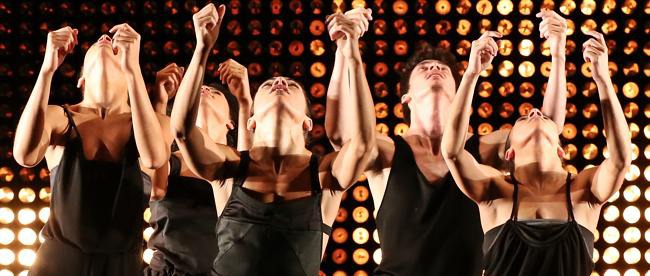Home | Blog | Sydney Festival
Sydney Festival
Credit: Prue Upton – Shaun Parker & Company’s Am I
I have managed to welcome in the New Year as I do time and again, with the same gung-ho, all systems go, frenzy I experience after each Christmas hiatus. This past weekend alone I have checked in to class at Sydney Dance Company, bopped and grooved (as an extra) in a music video, and taken part in the Sasha Waltz masterclass care of Critical Path at The Drill Hall, before listening to the explanatory whys and wherefores of the inimitable Sasha Waltz herself, at the Goethe Institute.
So it’s no wonder I move with the stilted unease of a broken marionette, walking backwards down stairs at a snail’s pace, clutching and soothing each compromised limb.
But enough of my foolhardy endeavours.
As Sydney Festival draws to a close this coming weekend I have a chance to bask in the memory of performances witnessed back to back, to compare and reflect on the highlights, and to let the experiences inspire me to create. Some of the images that resonate with me still –
Josh Mu’s solo in Shaun Parker & Company’s Am I, a show that aims to tackle our very existence, from the big bang, to the stardust that sparked our evolutionary history, and the existence of God, listed by religious specificity. All to composer Nick Wales’ superb live musical accompaniment featuring strong vocal harmonies peppered with multicultural percussive high-pitched cries or yips and a clever lighting design with an impressive wall of LED lighting to assault and mesmerize in turn.
It was the very contemporary acknowledgement of a higher power, evocative of the African dances praising a pagan deity, the speaking-in-tongues of American church revivalists, or the physical commitment as seen (in documentaries) by Shakers, performed and expressed by Mu, utilising his own idiosyncratic movement language, which made this a powerful stand-alone moment.
The collective energy corralled by the ladies from Post in Oedipus Schmoedipus, a comprehensive theatrical history of death and dying, presented by Belvoir, with a cast of thirty, boosted by the inclusion of volunteers, who after just one rehearsal, managed to convey subtle humor amongst overt slapstick, to exist as a cast of individuals amongst a beautifully shambolic rabble, whilst moving and reading from autocue monitors, hoisted on high, above the audience.
Dalisa Pigram had me on the edge of my seat, holding her own, on a stage with only a net suspended from the ceiling and a large corrugated fibreglass backdrop, acting as projection surface, in Gudirr Gudirr. Her physicality, dynamic from beginning to end, her passion laid bare in an unpretentious sharing of circumstances as an Indigenous woman from Broome. This compelling performance blended video imagery with text; both written and spoken live, acrobatics and a contemporary indigenous movement language consisting of a series fast paced small isolations, requiring ultimate precision and physical dexterity.
I had heard that Sasha Waltz’s version of the opera Dido and Aeneas is unique in that the dance is not an inconsequential additive supplanted in the middle of the action, but the main event. What unfolded before me was a myriad of choreographic textures simultaneously layered and overlapped. It was certainly a visual feast consisting of an intricate barrage of detail indicative of the baroque period this opera hails from.
We entered the theatre to an impressive oversized water-filled fish tank, spanning the stage. Sasha intimated in her interview, that it is symbolic of the Mediterranean. The dancers entered and mingled aloft before gently immersing themselves to spin and swim in gentle swirls like the curlicues that adorn the busy paintings. Clothes were thrown to fall in puddles, bodies formed large organisms, formed an undulating sea, formed hectic scenes from high society, expressed frivolity and longing. This was a group of performers in performance that was well crafted, including the choir, who were indistinguishable from the dancers.
I am fortunate to have taken part, to have witnessed and to have heard some of the processes that underpin some of the great theatrical moments from this summer’s offerings. Ahh now for next year…
By Vicki Van Hout

